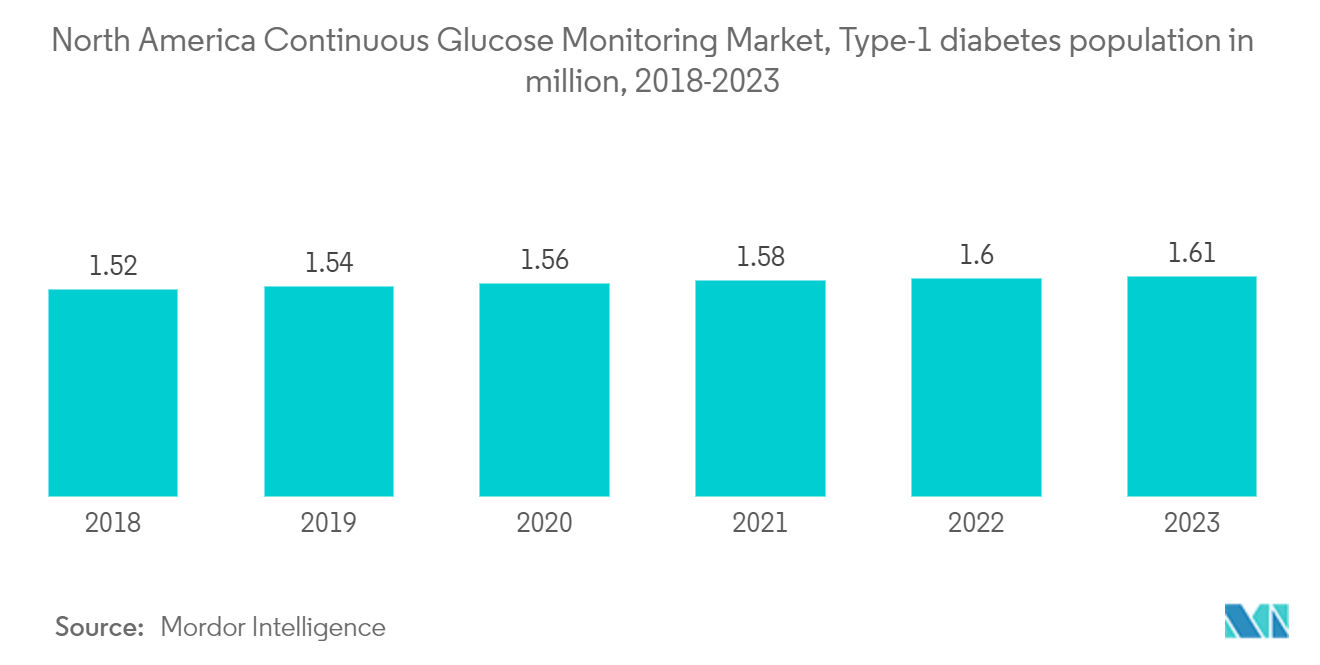Market Trends of North America Continuous Glucose Monitoring Industry
The sensors segment held the highest market share in the current year
To use a CGM, a small sensor is inserted into the abdomen or arm with a tiny plastic tube known as a cannula penetrating the top layer of skin. An adhesive patch holds the sensor in place, allowing for Interstitial Glucose Monitoring throughout the day and night. Generally, the sensors must be replaced every 7 to 14 days. A small, reusable transmitter connected to the sensor allows the system to send real-time readings, enabling Wireless Glucose Monitoring through a monitor device that displays blood glucose data. Some systems have a dedicated monitor, and some display the information via a smartphone app.
CGM sensors have proven to be effective for patients with frequent hypoglycemic events, sensor-augmented pumps, and gestational diabetes, treated with either continuous subcutaneous insulin infusion or a multiple daily injections insulin regimen. The market players are adopting various ways to increase CGM market share. For instance, to lower the cost burden of diabetic patients in the United States, Abbott, one of the leading CGM companies, in May 2022, introduced a new, lower-priced category with Libre at around USD 75 to USD 150 each month (2 sensors that last 14 days each).
Researchers are trying to find and develop alternatives to electrochemical-based Glucose Sensors and create more affordable, minimally invasive, and user-friendly CGM sensors. Optical measurement is a promising platform for glucose sensing. Some technologies with high potential in continuous glucose sensing have been reported, including spectroscopy, fluorescence, holographic technology, etc. Eversense, an Implantable Glucose Monitoring sensor based on fluorescence sensing developed by Senseonics Company, presents a much longer lifespan than electrochemical sensors.
Owing to the factors above, the growth of the studied CGM market is anticipated in the North America Region.

The United States held the highest market share in the current year
The United States held the largest share of about 92.1% in the Continuous Glucose Monitoring market in the North American region.
The Centers for Disease Control and Prevention (CDC) National Diabetes Statistics Report 2022 estimated that more than 130 million adults live with diabetes or prediabetes in the United States. Type 2 diabetes is more common, and diabetes is more consequential among communities of color; those who live in rural areas; and those with less education, lower incomes, and lower health literacy.
The frequency of monitoring glucose levels depends on the type of diabetes, which varies from patient to patient. Type-1 diabetic patients need to check their blood glucose levels regularly to monitor their blood glucose levels and adjust the insulin dosing accordingly. CGMs allow for improved glucose control because patients can see their glucose levels in real-time without the burden of performing a fingerstick. Using CGMs can eliminate the need for fingerstick Blood Glucose Monitoring. The use of CGM by Type-1 diabetic patients is very less as compared to Type-2 diabetic patients. But the expenditure of Type-1 diabetic patients on these devices is nearly double that of Type-2 diabetics. However, high costs and uncertainties about their efficacy and necessity have kept CGM from being widely used by people with Type-2 diabetes.
Furthermore, the current Continuous Glucose Monitoring devices can either retrospectively display the trends in blood glucose levels by downloading the data or give a real-time picture of glucose levels through receiver displays. The newest CGM models, the Abbott Freestyle Libre 3 and the Dexcom G7, among the most popular CGM devices, overcame many technical barriers. Technological advances such as Eversense E3 CGMs have significantly improved the ability of providers to treat diabetes and for patients to manage their blood glucose levels.
According to the Centre for Health Care Strategies for Medicaid agencies that can cover and increase access to CGMs for their beneficiaries and the larger healthcare system, there is strong evidence that supports the benefits of CGM use for all people who are insulin-treated with an insulin pump or multiple daily insulin injections, and emerging evidence is showing the benefit of CGMs in patients on basal insulin.
Therefore, owing to the factors above, the growth of the studied North America Continuous Glucose Monitoring market is anticipated.


